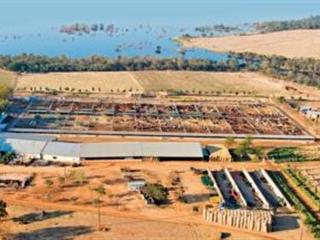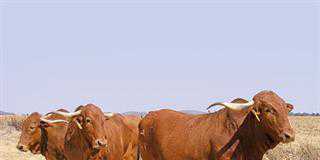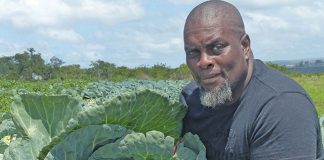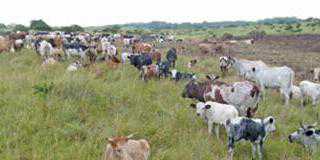
The Cappuccino Pinzgauer Stud forms part of Bertie van Zyl Farming, widely known as ZZ2, based in the Mooketsi Valley in Limpopo, with farming operations in many other parts of the country. ZZ2 is an iconic South African farming business and a leader in the practice of biological farming methods.
READ:Running-a-successful-livestock-study-group
To expand the ZZ2 Pinzgauer breeding herd, Paul Bester, manager and key man of the livestock division of ZZ2, acquired Giepie Rossouw’s Rossgevonden Stud in 2010. The stud is now the Cappuccino Pinzgauer Stud alongside ZZ2’s three other Pinzgauer studs. The Cappuccino cow, PGJ 03 0081, recently won the Farmer’s Weekly-ARC Best Elite Pinzgauer cow at the Spring Show.
The company’s livestock division runs the biggest herd of registered Pinzgauer cattle in the world, as well as herds of registered PinZ2yl, Nguni and Santa Gertrudis cattle. A commercial weaner operation, cross-breeding with Brahman, Santa Gertrudis and Pinzgauer for maximum benefit from hybrid vigour, it produces weaners for its own and other major South African feedlots.

Paul Bester and Martin Seyfferdt, well-known cattle consultant at a study group day in Mooketsi. Photo courtesy of ZZ2
“The aim of the ZZ2 livestock division is to farm ethically according to conservation principles, while taking advantage of modern technology,” says Paul. Every ZZ2 operation has its own cost centre and is economically independent. There is no cross-subsidisation between different operations.
Four studs
The first Pinzgauer stud herd was founded by the late Bertie van Zyl, an astute businessman and visionary farmer who was the driving force behind the remarkable growth of ZZ2 farming. Bertie obtained a group of Pinzgauers from Namibia in 1960 before importing more of these cattle from Austria in 1962. In 2006, Pinzgauers imported from the Omateva Stud in Namibia formed the basis of the Grootboom Pinzgauer Stud.
The Koue Bokkeveld Pinzgauer Stud is in Ceres in the Western Cape and the Rossgevonden Stud is now the Cappuccino Pinzgauer Stud. “With 1 200 registered Pinzgauer breeding cows in the four stud herds, it makes sense to keep the dam lines separate,” explains Paul.
Cattle graze the abundant sweet bushveld grass at a stocking rate of 10ha/MLU. Grazing is integrated with the tomato production programme and fenced, fallow tomato lands are stocked at a rate of 4ha/ MLU. This helps ZZ2’s natuurboerdery (farming with nature) principle of incorporating organic material into the soil, and complements the overall farming programme at ZZ2, utilising natural regrowth and volunteer grass growth.

Pinzgauer bull, Chapter 2, sired by Mr Silence, shows the breadth, depth and beef capacity of the breed.
The men behind the herds
ZZ2 was founded more than 50 years ago, and is now one of the largest agricultural companies in South Africa. Bertie was the president of the Pinzgauer Cattle Breeders’ Society of South Africa (PCBSSA) and of the International Pinzgauer Cattle Breeders’ Association (IPCBA), holding the latter position from 1993 until his death in 2005.
Bertie’s son Tommie, CEO of ZZ2 and vice-president of the IPCBA, sponsors and supports development and research on the PinZ2yl and is the guardian of the PinZ2yl breed. Paul, a respected cattleman, has been key to the success of the Pinzgauer breed. He is currently the president of the PCBSSA and chairperson and founder of the PinZ2yl Cattle Breeders’ Club.
PinZ2yl is a breed which crosses Nguni dam lines with Pinzgauer sire lines. Paul developed the PinZ2yl cattle through on-farm trials and meticulous record-keeping and presented his data to the department of agriculture in 2009. This has led to the PinZ2yl’s registration status as a cattle breed under evaluation. ZZ2 runs two PinZ2yl stud herds, the Rainbow Stud in the Koue Bokkeveld near Ceres, and the Mathomo Stud at Mooketsi, with about 1 200 breeding cows between them.
Paul initiated and executed the Pinzgauer Road Show in 2009 and 2010. It attended 15 agricultural shows with ZZ2 Pinzgauer champions competing in every interbreed event. ZZ2’s bull, Mr Silence B 04 0021, won the Gold Cup for Best Animal on Show at three major shows, including the Pretoria Show and the Royal Agricultural Show in Pietermaritzburg.
About the Pinzgauer
The Pinzgauer originates from the Pinzgau region in Austria and has been around since 400AD. Pinzgauer cattle were first imported to South Africa from Austria by Bertie van Zyl in 1962. Their descendants graze the Mooketsi Valley in Limpopo. The Pinzgauer has a distinctive dark chestnut brown coat with a white back, white flanks and underbelly. It has a medium frame build with good breadth, depth and immense beef capacity. Pinzgauers are renowned for their longevity. Bulls continue to breed up to 12 years of age. Cows have a lifespan between 16 and 18 years and sometimes up to 21 years.

Francois de Chalain, ZZ2 studmaster, discusses important traits in the Pinzgauer female at a ZZ2 stockman’s day.
Taking Pinzgauers to the people
Grootboom Estate is the ZZ2 livestock division’s training base and many training and development events for Pinzgauer breeders have been held there. Part of the ethic of ZZ2 is to share knowledge and expertise in a pro-active move to upskill fellow breeders and cattlemen. It held a stockman’s training weekend in July, and a Molatek show cattle assessment course in October 2011.
“Training is vital,” says Paul. “We made many mistakes in the 1990s which led to a dramatic decline in the number of registered Pinzgauer herds, until we reached a low point in 2004 when there were only four herds left.” He sat down and analysed the problems, determined to overcome them. Since then, the breed has made a significant recovery and there are now 84 Pinzgauer herds and 66 PinZ2yl herds in South Africa.
“We achieved this by opening up the gene pool and making the best genetics freely available, especially to new breeders. Of course, there is a price to pay for genetic excellence,” he adds. In 1998, Paul began to breed a South African type of Pinzgauer adapted to a subtropical environment and extensive grazing conditions, without the need for supplements.
While maintaining high milk production, the beef qualities of this dual purpose breed are now such that, at this year’s Spring Show in Pretoria, the Pinzgauer bull, Cappuccino Z 10 0464 Zorro, won the prestigious Vleissentraal-ARC Special Performance Test Class award. ZZ2’s Pinzgauer cows have won the Farmer’s Weekly-ARC Best Elite Cow Award six times between 1998 and 2012.
Study groups
With Isaih Ramothwala, a ZZ2 studmaster, and fellow Pinzgauer breeder Mitch van den Bos of the Bosheuvel Pinzgauer Stud near Muldersdrift, Paul set up study groups in the PCBSSA. He mentors many new and established cattle breeders and in 2006 launched the first Pinzgauer mentorship programme, the Limpopo study group, with six members. This group has grown to 58 members.
In the study groups, new breeders are helped to obtain top quality genetics and taught about the proper establishment and management of a herd. Study groups allow farmers to network and share knowledge, particularly important for developing farmers. This approach played a strong role in the resurgence of the breed with its inherent qualities of excellence and economic production.
Paul was honoured in 2011 with an SA Studbook award for “the breeder in South Africa who gives exceptional aid to developing and upcoming farmers”. He has an understanding of indigenous cultures and is fluent in several African languages. This means he is able to mentor emerging farmers in their mother tongue which makes his experience and knowledge more accessible. “When words fail, I speak with the language of the hands,” says Paul.
News for the new year
Pinzgauer and PinZ2yl cattle will go on a road show in 2013, provisionally covering Nampo, Bloemfontein, Vryburg, the Royal Show, Thabazimbi, Bela Bela, Pretoria, Standerton, Bredasdorp and Moorreesburg. The Pinzgauer World Congress takes place in South Africa in August 2013. Delegates will tour the country and meet South African breeders and their Pinzgauers. For more information, phone Paul Bester (details below).
Farmer’s Weekly-ARC 2012 Best Elite Pinzgauer cow
PGJ 03 0081 was born on 25 January 2003 in Giepie Rossouw’s Rossgevonden Stud. Her dam was PGJ 96 0048 and her sire was PM 97 0029. By the age of nine, she had had eight calves, (two bull calves and six heifers). The first calf was born when she was 32 months old. The September 2009 calving gave a set of twins (both heifers, one of which died at 3 months).
In ARC’s analysis for the award her average ICP was 370 days, her reproduction index 111, her average weaning index 195 and her efficiency index 97. Her birth weight EBV (direct) was -0,25 (accuracy 81); her birth weight EBV (maternal) was -0,85 (accuracy 79). Her weaning weight EBV (direct) was 2,60 (accuracy 72) and her weaning weight EBV (maternal) was 2,70 (accuracy 76). Of her eight calves, five (one bull and four heifers) have been retained in the herd.
Contact Paul Bester, ZZ2 Livestock Division, on 083 627 6899 or at [email protected].













